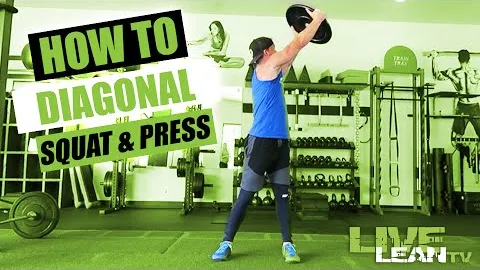
Are you looking for an effective full-body exercise that will challenge your muscles and help you improve your strength and coordination? Look no further than the diagonal squat and press exercise. This dynamic movement targets multiple muscle groups simultaneously, making it a valuable addition to any workout routine. In this article, we will provide a step-by-step guide on how to perform the diagonal squat and press exercise correctly, along with the benefits it offers and tips for proper form.
The diagonal squat and press exercise is a compound movement that combines a squat with an overhead press. It involves using your lower body muscles, such as the quadriceps, glutes, and hamstrings, to perform a squat, while simultaneously engaging your upper body muscles, specifically the shoulders and triceps, to perform an overhead press. The exercise is typically performed with a dumbbell or kettlebell, adding resistance to further challenge your muscles.
To perform the diagonal squat and press exercise correctly, follow these steps:
Starting Position: Stand with your feet shoulder-width apart, holding a dumbbell or kettlebell in your right hand. Position the weight at shoulder height, with your palm facing inward (towards your body).
Squat: Initiate the movement by bending your hips and knees, lowering your body into a squat position. Keep your chest up, back straight, and core engaged throughout the movement.
Twist: As you reach the bottom of the squat, twist your torso to the left, simultaneously rotating the weight in your right hand towards your left foot. Your right elbow should point towards the ground, and your left arm should be extended diagonally upward.
Press: From the twisted position, engage your legs and push through your heels to rise back up to a standing position. Simultaneously, push the weight overhead by extending your right arm fully. Your right palm should be facing forward at the top of the movement.
Return to Starting Position: Once you've reached the top of the movement, lower the weight back to shoulder height while twisting your torso back to the starting position. Repeat the exercise for the desired number of repetitions before switching sides.
Incorporating the diagonal squat and press exercise into your fitness routine offers numerous benefits, including:
The diagonal squat and press exercise engage multiple muscle groups simultaneously, providing a comprehensive full-body workout. It targets the quadriceps, hamstrings, glutes, shoulders, triceps, and core muscles. By targeting multiple muscle groups at once, you can save time while effectively working your entire body.
Since the diagonal squat and press exercise involves both lower and upper body movements, it helps build strength and power throughout your body. The legs work hard to perform the squat, while the shoulders and triceps are engaged during the overhead press. This compound movement challenges your muscles and helps improve overall strength and power.
Performing the diagonal squat and press exercise requires coordination and stability, as you have to twist your torso while performing a squat and overhead press simultaneously. This exercise improves your overall coordination and enhances stability in your core and lower body muscles.
As a compound movement that utilizes multiple muscle groups, the diagonal squat and press exercise can help increase your calorie burn. Engaging large muscle groups, such as the quadriceps and glutes, requires more energy expenditure, helping you burn more calories during your workouts.
The diagonal squat and press exercise mimics natural movement patterns, making it a functional exercise that translates to real-life activities. It improves your ability to perform daily activities that involve squatting, twisting, and lifting. Incorporating functional movements like this into your fitness routine can improve your overall functional fitness.
To maximize the benefits and reduce the risk of injury while performing the diagonal squat and press exercise, consider the following tips:
Always start with lighter weights or no weight at all to master the movement before progressing to heavier resistance.
Keep your back straight and chest up throughout the exercise to maintain proper posture and prevent strain on your lower back.
Engage your core muscles by pulling your navel towards your spine during the movement. This helps stabilize your spine and protects your lower back.
Maintain a slow and controlled movement throughout the exercise. Avoid using momentum or swinging the weight to ensure you are effectively targeting the intended muscle groups.
Breathe properly during the exercise. Inhale as you lower into the squat position, exhale as you rise up, and continue exhaling as you push the weight overhead.
The diagonal squat and press exercise is a highly effective full-body movement that provides a range of benefits, including improved strength, coordination, stability, and calorie burn. By following the step-by-step guide and incorporating proper form, you can fully enjoy the advantages this exercise offers. Remember to start with lighter weights, focus on maintaining proper form, and progress gradually to challenge your muscles further. Incorporate the diagonal squat and press exercise into your fitness routine to enhance your overall strength, power, and functional fitness.
If you're looking for a gym, fitness club or yoga studio, you've come to the right place.
You can find information about gyms in your area. Browse catalog of gyms and find gyms with classes which are you looking for.
On gym page you can find simple information like address, phone or website. You can find list of available classes. You can check availability of personal training or small group classes. On place page you can also see information about open hours.
You can find gyms near you with amenities, courts, studios and equipments.
Use our map to find gym at your city or district.
In Gym Navigator you can find list of exercises with movies for many body parts.
You can browse exercises catalog and find exercises the best of you.
You can also find exercises grouped into workout plans, which you can use to improve you body. Each routine show you exercises one by one and give you possibility to count you progress and count down rest time.